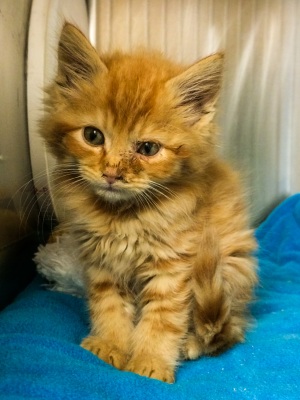San Jose Shelter Pushes Forward and Strives to Save More Kittens Each Year
The summer is when kitten season is in full swing. Because cats are such prolific reproducers, animal shelters tend to become overrun with kittens during the summer months (or, more accurately, most of the year in California animal shelters). With such a high influx of kittens, it is often hard for shelters to keep up with them and the care they require.
Many shelters euthanize kittens under two pounds upon entering the shelter, even if they are healthy. You can imagine what the fate is for kittens that are not healthy. The San Jose Animal Care Center (SJACC) does not follow this practice. Rather, the SJACC has worked hard to save a higher percentage of kittens each and every year and has gradually decreased the weight at which the shelter’s veterinarians feel it is safe to perform surgery (using special protocols for these fragile mini-kitties) and adopt out kittens. As of 2014, the minimum weight kittens must be for surgery to be performed at SJACC is 1.3 pounds.
The SJACC relies on a network of animal rescues and foster homes to care for underweight kittens in order to free up space in the shelter for other cats and kittens. Animal rescues are critical players when it comes to taking newborn kittens with or without their mothers as they require an intense feeding schedule, typically eating every 2 hours.
Not only is the SJACC working to save a higher percentage of kittens that are under the 2-pound mark, the shelter is also working hard to save kittens that are sick or injured.
Upper respiratory infections (URI) are prevalent in cats as it is, and kittens with their still-developing immune systems are prone to getting sick. Kittens also come into the shelter with various injuries such as broken legs, burnt paw pads, and lacerations, many of which occur when they hide and get caught in car engines and have to be rescued by the Animal Services Officers. All of these issues are treated by the veterinarians at the SJACC. In fact, the shelter has not euthanized any cats or kittens since the beginning of 2013 for having URI.
While there is still room to increase the percentage of cats and kittens saved, the shelter is ahead of the curve when it comes to saving feline lives. The national average for the number of cats saved is about 60%, whereas SJACC saves approximately 80%!
If you haven’t already done so, check out the story of Braveheart as an example of the incredible work that the medical staff does on a daily basis.
Posted on August 24, 2014, in Shelter Vet Tails and tagged 1.3, 2-Pound, Adoption Rate, Amputation, Animal Control, Animal Services, Animal Services Officer, Animal Shelter, Animal Shelter Veterinarian, Average, Bottle Babies, Braveheart, Broken Leg, Burned, Burnt, Cat, Doctor, DVM, Emergency, Euthanasia, Euthanize, Feed, Forever Home, Foster, Foster Home, Fracture, Fractured Leg, Happy, Happy Ending, Injured, Kitten, Kittens, Laceration, Law, Legislation, National Average, No Kill, Nursing, Officer, Pad, Paw, Pound, Queen, Rescue, Rule, San Jose, San Jose Animal Care & Services, San Jose Animal Care Center, Save, Save Rate, Shelter, Shelter Medicine, Shelter Vet Tails, Shelter Veterinarian, Sick, Surgeon, Surgery, Tails of a Shelter Vet, Trauma, Two Pound, Vet, Veterinarian, Weight, Wound. Bookmark the permalink. Leave a comment.

Leave a comment
Comments 0